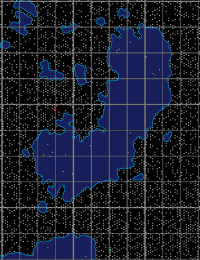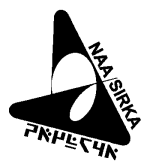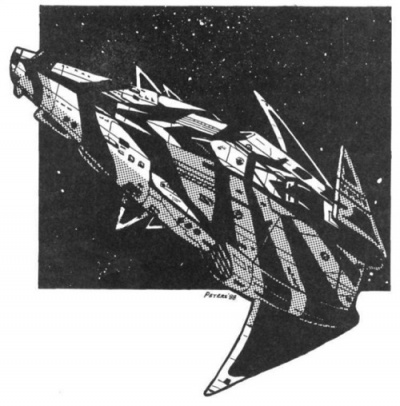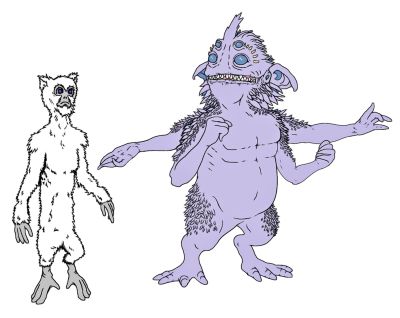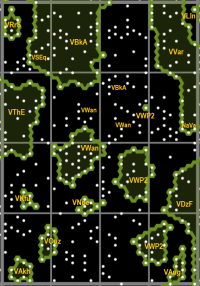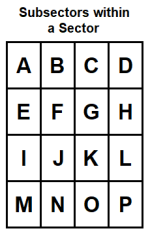Tuglikki Sector
| Tuglikki Sector | |||||||||||||||||
|---|---|---|---|---|---|---|---|---|---|---|---|---|---|---|---|---|---|
| |||||||||||||||||
| Subsectors | |||||||||||||||||
|
| |||||||||||||||||
| Sector Data | |||||||||||||||||
| No. of Worlds | 374 | ||||||||||||||||
| Population | 728,972 million | ||||||||||||||||
| Majority Control | Vargr Extents - 100% | ||||||||||||||||
| Domain | Vargr Extents Balkanized Space | ||||||||||||||||
| Capital | Various | ||||||||||||||||
| Gross Sector Product | BCr4,137,646 | ||||||||||||||||
| Trade Volume | BCr35,346 | ||||||||||||||||
| Imperial Coordinate | -3 / +2 | ||||||||||||||||
| This sector has a trade map | |||||||||||||||||
| This sector has economic data | |||||||||||||||||
| This sector has sector data | |||||||||||||||||
| This sector has a climate file | |||||||||||||||||
| This sector has sector data | |||||||||||||||||
|
Tuglikki style="width: 250px; height: 350px; border: solid 1px black; float: right; clear: left" | |||||||||||||||||
Tuglikki Sector is an extremely turbulent Vargr-dominated region lying to coreward of the Imperial Domain of Deneb.
- It is solidly Vargr Space and part of the Vargr Extents.
- It is known as Dravr Sector to the Zhodani.
- It is considered the epitome of Balkanized Space.
Description (Specifications)
The sector is a major crossroads within the Vargr Extents, close enough to the Imperium to maintain lucrative trade relations. Many of the small polities that lie within its borders are fierce rivals, competing against one another for territory, prestige, influence, and any commercial advantage they can get.
- The interchange of Imperial Vargr and native Vargr helps promote the development of ideas, skills, and technologies within the region.
- Zhodani and Vilani influences can also be noted by the discerning observer.
Slavery is practised on many worlds within the sector. Its coreward regions - particularly a trade route within Gaerith Subsector known as the Zurekhaz - are a hub of the interstellar slave trade. Slavery is enormously profitable for everyone involved except the slaves: it has the support of many powerful interests keen to see the status quo maintained.
- The Empire of Varroerth has taken proactive measures against the slave trade, occupying a number of worlds known to be involved in the practise.
- There are active, armed abolitionist movements on many worlds across the region and underground railroad organizations are known to exist.
Astrographic Features
The following astrographic and commercial data regarding the sector has been determined:
- The spinward-coreward regions and the center of the sector are lower density regions: the remainder of the sector is considered to be standard stellar density.
- A number of small rift regions lie within the sector. They form part of the greater complex of rifts and voids associated with the Windhorn Rift.
- The brightest star is the unstable red bright giant primary of the Zaekong system, located in the rimward half of the sector.
- A number of small but important trade routes lie within the region, most notably the Dokh Cluster, the Wanz Cluster, and the notorious Zurekhaz.
Stellar Distribution
A basic map showing the distribution and size of stars within Tuglikki Sector.
- The color corresponds to the visible color of the star, which links to its spectral classification.
- The size as shown indicates both the physical size of the object and its relative brightness.

(Chart sourced from Traveller Map).
Note that the stars as depicted are representative. Any star, no matter what its size, is a mere speck within the hex it occupies.
- Ordinary main sequence stars can barely be seen from even a hex away.
- Huge, intensely luminous giant stars can be seen from across the sector and far beyond.
Rifts and Voids
The sector contains a complex of rifts and voids associated with the Windhorn Rift, lying to trailing.
- Rift regions hinder travel and commerce across the region.
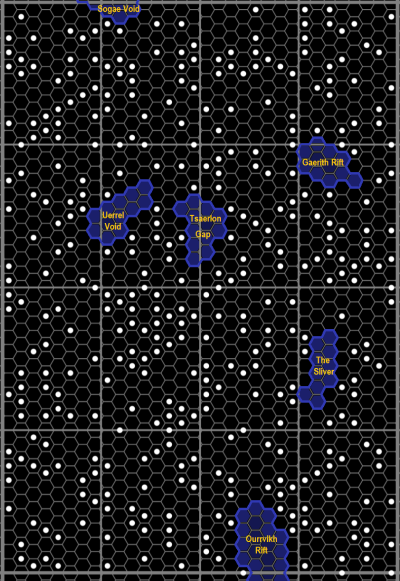
(Chart sourced from Traveller Map)
Locally at least, a rift is an astrographic concept based on Jump Drive performance.
The boundaries of rifts were established centuries ago, when the highest commonly encountered tech level was TL–12.
- This level of technology allowed the routine use of up to Jump-3 drives.
- Areas that couldn't be crossed by Jump-3-capable vessels were denoted as rifts.
This traditional definition of rift regions remains in use today: while modern high performance starships can easily cross them, most commercial vessels continue to utilize Jump-3 or less drives. Because of this most traffic is concentrated within higher stellar density regions, and as such the classic definition and boundaries of rift regions remains relevant.
Economic Astrography
Corporations
Several major corporations operate within the sector:
- The Imperial Megacorporation Naasirka, with historical ties to coreward regions, maintains a significant presence within the sector.
Vargr Corsairs
Vargr Corsair bands can pose a considerable risk to interstellar trade and commerce within the sector.
- Corsairs can often be negotiated with and many accept tribute in return for safe passage through their territory.
- Vessels and crews are advised to travel armed and ready to defend themselves.
Trade Routes
A number of trade routes exist within this area. Of these, the most important are:
Dokh Cluster
The Dokh Cluster lies within the spinward-coreward quadrant of the sector. It is a small Cluster.
- It has 14 member systems.
- A number of its coreward systems are controlled by the Bakne Alliance.
All of the Cluster's worlds have declared themselves to be members of the Society of Equals, a Vargr polity in Gvurrdon Sector. They share a cultural heritage with the Society as well as many of that state's broad political and ethical views.
- For reasons of practicality most hold non-incorporated member status (effectively they are neutral worlds).
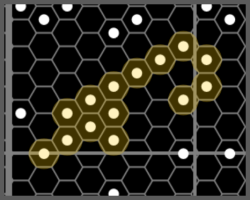
(Chart sourced from Traveller Map)
- Worlds lying within the Cluster are highlighted in tan.
Dzarrgh Run
One world, lying in the far rimward-trailing corner of the sector, is a member of the Dzarrgh Run, a trade route primarily running between Provence Sector and Corridor Sector. It is a small Main.
- It has 28 member systems.
- A few of its coreward worlds lie within the Irrgh Manifest, a Vargr polity.
- Its central worlds run through Balkanized Space and the Imperium.
- Some of its spinward worlds are members of the Dzarrgh Federate, a Vargr polity.
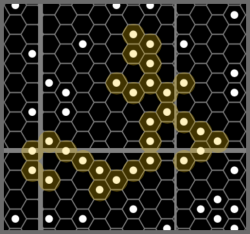
(Chart sourced from Traveller Map)
- Worlds lying on the Run are highlighted in tan.
Wanz Cluster
The Wanz Cluster is an important trade route lying in the center of Tuglikki Sector. It is a small Main.
- It has 28 member systems. It is named for Wanz, its primary world.
- The majority of its worlds lie within the People of Wanz, a Vargr polity.
It is closely associated with the Ksar Trace, a small cluster slightly to coreward.
- The Trace has 6 member systems. It is named for Ksar, its primary world.
- The inhabitants of the Trace share a common cultural heritage with the Wanz Cluster, their rimwardly neighbours.
- Their worlds hold unincorporated member world status.
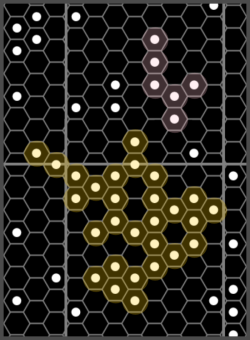
(Chart sourced from Traveller Map)
- Worlds lying within the Wanz Cluster are highlighted in tan.
- Worlds lying within the Ksar Trace are highlighted in brown.
Zurekhaz
The Zurekhaz is a small but important trade route lying on the trailing edge of Tuglikki Sector and crossing into Provence Sector. It is a small Main with a dark reputation as a hub of the slave trade.
- It has 22 member systems. The majority of its worlds are staunchly neutral.
- A number of its trailing systems have been seized by the Empire of Varroerth.

(Chart sourced from Traveller Map)
- Worlds lying within the Zurekhaz are highlighted in tan.
World Listings
Comprehensive Second Survey UWP data for all worlds lying within the sector is available.
- The primary source material for all data is Traveller Map.
- Other sources may contain contradictory or incorrect information.
Note that some Second Survey data, though only 40 years old, is likely to be out of date.
- Data is occasionally updated as new information becomes available.
- Scouting missions gathering reliable, verified data can receive substantial payment.
- Verified updated data is constantly sought.
History & Background (Dossier)
Vargr are the majority population within the sector. Humans from a variety of backgrounds, Dhaen , outcast Aezorgh, and wandering Hlanssai may also be met.
Demographics
The total population of Tuglikki Sector is estimated at 728.972 billion sophonts.
Significant populations of the following sophont races reside within this sector:
- Terragens (Non-human Terran races)
- Vargr (Major Race): the majority population within the sector.
- Non-Human Races
- Aezorgh of Soghzalghag, in Windhorn Sector: sparsely distributed across the Vargr Extents. Their name translate as vermin.
- Some are integrated into communities but the majority live as opportunistic outcasts on the fringes of society.
- Bwaps of Marhaban, in the Empty Quarter: Bwap communities trailed the Vilani, as elsewhere in Charted Space. The rather chaotic conditions typical of the Vargr Extents are not an environment in which Bwap generally thrive, but some small communities remain as "protected resources" of Vargr or human powers.
- Chirpers of Eskayloyt (unknown sector): one small community is located on the world of Doukgzaeroun.
- Dhaen of Dhaen, in Provence Sector: small, long-bodied, fur-covered humanoids not recognized by the Vargr as being sophont.
- Some Vargr keep them as pets or as servants.
- Hhkar of Skkyhrk, in Amdukan Sector: very large, powerfully built, carnivorous, egg-laying, generally humanoid reptillianoids.
- The species have maintained small settlements and colonies in a broad sphere around their distant homeworld for millennia.
- Hlanssai of Vrirhlanz, in Gzaekfueg Sector: sensual, impulsive, emotional humanoids with a strong wanderlust who may occasionally be encountered in small groups.
- They are considered "unstable" by the notoriously unpredictable Vargr.
- Raekhsva of Uel Raekhsva: semi-aquatic non-humanoids from a technologically backward tainted atmosphere water world dotted with volcanic islands and archipelagos.
- Aezorgh of Soghzalghag, in Windhorn Sector: sparsely distributed across the Vargr Extents. Their name translate as vermin.
- Humaniti (Human Races)
- Mixed heritage, most commonly Travellers, traders, or captives held in bondage by the Vargr.
- Solomani, primarily from long-established families.
- Vilani, primarily from long-established (and often reclusive) families.
- Zhodani, mostly Consular officials conducting state affairs or far-flung merchants and traders.
Linguistic Topography
The following languages are among the most commonly used within this region:
- Aekhu - a widely spoken Vargr language.
- Gvegh - an older but still widely spoken Vargr language.
- Riftian Anglic - The local dialect of one of the Imperium's two official languages.
- Vilani - one of the Imperium's two official languages.
Toponyms
This sector has been known by different names to different groups over its existence including the following:
| Tuglikki Sector Names | ||
|---|---|---|
| Culture | Toponym | Polity |
| Third Imperium | Tuglikki | Third Imperium |
| Aslan | Tuglikki | Aslan Hierate |
| Droyne | Unknown | Droyne Oytrip Yatroy |
| Hiver | Dravr | Hive Federation |
| K'kree | Unknown | Two Thousand Worlds |
| Solomani | Tuglikki | Solomani Confederation |
| Vargr | Tuglikki | Vargr Extents |
| Vilani | Tuglikki | Third Imperium |
| Zhodani | Dravr | Zhodani Consulate |
Some experts believe the name of the sector is a corruption of a condescending Anglic phrase describing the behaviour of non-sentient Terran canines - they tug at things and lick at themselves.
- Some Vargr can see this framing of the name as deliberately derogatory, though it depends on prononciation, syllable emphasis, and context.
Faith and Belief
A number of religious faiths are followed within the sector:
- Church of the Chosen Ones (followed across the Vargr Extents).
- Faarzgaen-worship (followed within the coreward half of the sector.
- Senghik Outoun (scattered pockets across the Vargr Extents)
- Taarskoism (followed across the sector).
Historical Eras
General Overview:
- First Diaspora
- Second Diaspora (the Vargr Pillaging)
- Sack of Gashikan (Second Empire of Gashikan)
- Wolvesbane Project (Vargr Race Wars / Gashikan Race Wars)
- Establishment of the Third Imperium
- Pacification Campaigns
- Julian Wars
- Vargr Campaigns
- Golden Age
Sector Timeline
Major events that have affected this sector and the wider region that it lies within:
- -3810: the Vargr discover jump technology and begin an era of expansion.
- -3700s onwards: waves of Vargr settle worlds across the region.
- -2530: Collapse of the Foergaz Coalition.
- -2404 to -2215: the human Interstellar Wars rage to rimward.
- -1776 to 0: the Long Night. There is widespread regression within the area and some worlds become barren.
- -1700 onward: Vargr expansion and settlement gradually ceases.
- -1658: the Sack of Gashikan, an atrocity known throughout the coreward parts of Charted Space.
- -1483 to -321: the Gashikan Race Wars rage between human and Vargr extremists across the Extents.
- -1427: the Wolvesbane plague is released in Gashikan Sector, decimating Vargr populations.
- The Year 0: to rimward, the Third Imperium is founded.
- circa 26: the Empire of Varroerth is founded.
- 175 to 191: the Julian War.
- 220 to 348: Imperial Vargr Campaigns.
- 300-420: the Imperial First Survey charts the sector.
- mid 500s: the Knokseng Confederation is founded.
- 792: the Thoengling Empire is founded.
- 995-1065: the Imperial Second Survey charts the sector.
- 1065: the Second Survey is published. Information about the sector becomes widely available.
- 1080s: the Knokseng Confederation is dissolved.
- 1090: the Dzarrgh Federate is formed.
- 1090s: founding of the United Followers of Augurgh.
Worlds, Systems & Sectors (Political Astrography)
Political Astrography
A number of broad astropolitical areas are found within Tuglikki Sector:
- Vargr Extents: worlds and systems occupied by the Vargr or under the dominion of one of the major Vargr polities within the region. Many rimward worlds have small human communities and "infestations" of Aezorgh.
- Balkanized Space: regions containing non-aligned world-states: they make up the majority of the worlds in the sector.
Polity Listing
The following polities can be found within this sector:
- Vargr Extents - (Vargr powers):
- Non-Aligned Powers (World-States)
- Non-Aligned, Vargr-dominated.
- Other Powers
- Assemblage of 1116 (later polity).
- Eraghodo Concordat (historical polity).
- Foergaz Coalition (historical polity).
- Society of Equals (Gvurrdon Sector polity).
Polity Descriptions
Synopses of the polities found within this sector:
- Allegiance Code NaVa: Non-Aligned, Vargr-dominated - neutral worlds, or slaver worlds occupied by the Empire of Varroerth.
- Allegiance Code VAkh: Akhstuti.
- Allegiance Code VAug: United Followers of Augurgh.
- Allegiance Code VBkA: Bakne Alliance and non-incorporated member systems.
- Allegiance Code VDzF: Dzarrgh Federate.
- Allegiance Code VKfu: Kfue.
- Allegiance Code VLIn: Llaeghskath Interacterate.
- Allegiance Code VNoe: Noefa.
- Allegiance Code VOuz: Ouzvothon.
- Allegiance Code VRrS: Rranglloez Stronghold.
- Allegiance Code VSEq: Society of Equals (all non-incorporated systems with cultural ties).
- Allegiance Code VThE: Thoengling Empire.
- Allegiance Code VVar: Empire of Varroerth.
- Allegiance Code VWan: People of Wanz and non-incorporated member systens.
- Allegiance Code VWP2: Windhorn Pact of Two.
Capitals
The following worlds have been designated as capitals:
- Allazkhor is the capital of the Windhorn Pact of Two in the Ourrvikh Subsector.
- Angknul is the capital of the Windhorn Pact of Two in the Aenkazarr Subsector.
- Aroegsukgnu is the capital of the Rranglloez Stronghold in Dokh Subsector.
- Augurgh is capital of the United Followers of Augurgh in the Aegaek Subsector.
- Dokh is the capital of the Bakne Alliance in Dokh Subsector.
- Okh Kfuekhue is the capital of Kfue in the Kaeng Subsector.
- Olkouthte is the capital of the People of Wanz in Uerrul Subsector.
- Orghoungvog is the capital of those neutral worlds aligned to the Bakne Alliance in Tsaerlon Subsector.
- Otothoekh is the capital of the Thoengling Empire in Darrgouts Subsector.
- Uel Aekhsrroekh is the capital of the Empire of Varroerth in Knoukhs Subsector.
- Uel Ruekoza is the capital of those neutral worlds aligned to the People of Wanz in Tsaerlon Subsector.
- Ungakne Oekh is the capital of the Dzarrgh Federate in the Onrakae Subsector.
- Wanz is the capital of the People of Wanz in the Ludzghaeth Subsector.
Imperial Territory
No part of the sector has ever officially been an Imperial possession. Individual worlds along the rimward border have occasionally been briefly occupied by Imperial forces.
Sector Summary
The Tuglikki sector has 372 worlds with an estimated population of 543 billion, a per capita income of Cr5,601, and a total economy is BCr3,041,671. These worlds originate an interstellar trade of BCr10,838 through 327 starports (67 Class A, 104 Class B, 111 Class C, 45 Class D) employing 2,399,575 people. Driving this interstellar trade are 59 Agricultural (Ag) worlds, 17 Non-Agricultural (Na) worlds, 26 Pre-Agricultural (Pa) worlds, 43 Pre-Industrial (Pi) worlds, 35 Rich (Ri) worlds, and 17 Industrial (In) worlds. The governments in Tuglikki maintain 98 Naval bases, and 69 Corsair bases. The average technology level is 8 (with most between 6 and 11). The highest technology level is 15 at Kirzngoegh (Tuglikki 3212) and Augurgh (Tuglikki 3037).
The Tuglikki sector contains 461 stars and 4,855 identified planets; 289 monostellar systems, 77 binary systems, six trinary systems, and no systems with four or more stars. 356 of the 372 systems (95%) have native gas giants. There are 12 Asteroid (As) belts, 15 Desert (De) worlds, 11 Garden (Ga) worlds, eight Ice-capped (Ic) worlds, 56 Poor (Po) worlds, 30 Vacuum (Va) worlds, and 36 Water (Wa) or Ocean (Oc) worlds.
Tuglikki has an estimated population of 543 billion distributed across 37 High population (Hi) worlds, 31 Moderate population (Ph) worlds, 141 Non-industrial (Ni) worlds, 103 Low population (Lo) worlds, and no Barren (Ba) worlds. The highest population worlds are Okh Kfuekhue (Tuglikki 0629), Wanz (Tuglikki 1223), Noefa (Tuglikki 1629), Ungakne Oekh (Tuglikki 3126), Adhungna (Tuglikki 1836), and Gor Soell (Tuglikki 1534). The population consists of 3 sophont groups including one native sophont.
| 3 identified sophont populations in Tuglikki | |
|---|---|
Polities
Non-Aligned, Vargr-dominated
There are 121 Non-Aligned Vargr-dominated worlds in Tuglikki with an estimated population of 148 billion.
Bakne Alliance
The Bakne Alliance has jurisdiction over 45 worlds with an estimated population of 38 billion, a per capita income of Cr3,967, and a total economy is BCr153,315. These worlds originate an interstellar trade of BCr1,497 through 41 starports (8 Class A, 18 Class B, 11 Class C, 4 Class D) employing 251,635 people. Driving this interstellar trade are 11 Agricultural (Ag) worlds, one Non-Agricultural (Na) world, one Pre-Agricultural (Pa) world, five Pre-Industrial (Pi) worlds, three Rich (Ri) worlds, and one Industrial (In) world. The governments in Bakne Alliance maintain 14 Naval bases, and three Corsair bases. The average technology level is 9 (with most between 7 and 11). The highest technology level is 13 at Uel Galok (Tuglikki 1312) and Aes Zoeng (Tuglikki 1811).
The Bakne Alliance has an estimated population of 38 billion distributed across six High population (Hi) worlds, four Moderate population (Ph) worlds, 16 Non-industrial (Ni) worlds, 13 Low population (Lo) worlds, and no Barren (Ba) worlds. The highest population world is Uel Galok (Tuglikki 1312). The population consists of 1 sophont groups.
- The Bakne Alliance subsector capital of Saerrgh is Oekangae (Tuglikki 1105)
- The Bakne Alliance subsector capital of Tsaerlon is Orghoungvog (Tuglikki 1712)
People of Wanz
The People of Wanz has jurisdiction over 42 worlds with an estimated population of 85 billion, a per capita income of Cr6,876, and a total economy is BCr587,484. These worlds originate an interstellar trade of BCr499 through 37 starports (8 Class A, 14 Class B, 12 Class C, 3 Class D) employing 306,940 people. Driving this interstellar trade are six Agricultural (Ag) worlds, one Non-Agricultural (Na) world, two Pre-Agricultural (Pa) worlds, three Pre-Industrial (Pi) worlds, seven Rich (Ri) worlds, and one Industrial (In) world. The governments in People of Wanz maintain ten Naval bases, and five Corsair bases. The average technology level is 9 (with most between 7 and 11). The highest technology level is 14 at Uel Ruekoza (Tuglikki 1917), Ae Uefou (Tuglikki 1023), and Ae Anek (Tuglikki 1321).
The People of Wanz has an estimated population of 85 billion distributed across three High population (Hi) worlds, one Moderate population (Ph) world, 18 Non-industrial (Ni) worlds, 11 Low population (Lo) worlds, and no Barren (Ba) worlds. The highest population worlds are Wanz (Tuglikki 1223) and Kangangksirroz (Tuglikki 1316). The population consists of 1 sophont groups.
- The capital of People of Wanz is Wanz (Tuglikki 1223).
- The People of Wanz subsector capital of Uerrul is Olkouthte (Tuglikki 1220)
- The People of Wanz subsector capital of Tsaerlon is Uel Ruekoza (Tuglikki 1917)
Windhorn Pact of Two
The Windhorn Pact of Two has jurisdiction over 36 worlds with an estimated population of 7 billion, a per capita income of Cr4,640, and a total economy is BCr35,747. These worlds originate an interstellar trade of BCr451 through 31 starports (7 Class A, 8 Class B, 10 Class C, 6 Class D) employing 90,340 people. Driving this interstellar trade are five Agricultural (Ag) worlds, three Non-Agricultural (Na) worlds, five Pre-Agricultural (Pa) worlds, three Pre-Industrial (Pi) worlds, three Rich (Ri) worlds, and no Industrial (In) worlds. The governments in Windhorn Pact of Two maintain 13 Naval bases, and nine Corsair bases. The average technology level is 8 (with most between 5 and 11). The highest technology level is 14 at Allazkhor (Tuglikki 2335).
The Windhorn Pact of Two has an estimated population of 7 billion distributed across one High population (Hi) world, five Moderate population (Ph) worlds, 18 Non-industrial (Ni) worlds, eight Low population (Lo) worlds, and no Barren (Ba) worlds. The highest population world is Angknul (Tuglikki 2421). The population consists of 2 sophont groups.
- The capital of Windhorn Pact of Two is Angknul (Tuglikki 2421).
- The capital of Windhorn Pact of Two is Allazkhor (Tuglikki 2335).
Empire of Varroerth
The Empire of Varroerth has jurisdiction over 28 worlds with an estimated population of 31 billion, a per capita income of Cr8,174, and a total economy is BCr256,453. These worlds originate an interstellar trade of BCr4,354 through 26 starports (10 Class A, 6 Class B, 8 Class C, 2 Class D) employing 781,245 people. Driving this interstellar trade are three Agricultural (Ag) worlds, no Non-Agricultural (Na) worlds, three Pre-Agricultural (Pa) worlds, three Pre-Industrial (Pi) worlds, two Rich (Ri) worlds, and one Industrial (In) world. The governments in Empire of Varroerth maintain five Corsair bases, and five Naval bases. The average technology level is 9 (with most between 7 and 11). The highest technology level is 15 at Kirzngoegh (Tuglikki 3212).
The Empire of Varroerth has an estimated population of 31 billion distributed across two High population (Hi) worlds, two Moderate population (Ph) worlds, 13 Non-industrial (Ni) worlds, seven Low population (Lo) worlds, and no Barren (Ba) worlds. The highest population worlds are Uel Aekhsrroekh (Tuglikki 2707) and Kirzngoegh (Tuglikki 3212). The population consists of 1 sophont groups.
- The Empire of Varroerth subsector capital of Knoukhs is Uel Aekhsrroekh (Tuglikki 2707)
Thoengling Empire
The Thoengling Empire has jurisdiction over 23 worlds with an estimated population of 7 billion, a per capita income of Cr6,647, and a total economy is BCr48,212. These worlds originate an interstellar trade of BCr300 through 20 starports (6 Class A, 6 Class B, 6 Class C, 2 Class D) employing 68,895 people. Driving this interstellar trade are three Agricultural (Ag) worlds, no Non-Agricultural (Na) worlds, two Pre-Agricultural (Pa) worlds, one Pre-Industrial (Pi) world, five Rich (Ri) worlds, and two Industrial (In) worlds. The governments in Thoengling Empire maintain eight Naval bases, and two Corsair bases. The average technology level is 9 (with most between 6 and 11). The highest technology level is 13 at Otothoekh (Tuglikki 0115) and Aen Khue (Tuglikki 0221).
The Thoengling Empire has an estimated population of 7 billion distributed across two High population (Hi) worlds, four Moderate population (Ph) worlds, nine Non-industrial (Ni) worlds, five Low population (Lo) worlds, and no Barren (Ba) worlds. The highest population worlds are Otothoekh (Tuglikki 0115) and Keradh Oekh (Tuglikki 0512). The population consists of 1 sophont groups.
- The Thoengling Empire subsector capital of Darrgouts is Otothoekh (Tuglikki 0115)
Dzarrgh Federate
The Dzarrgh Federate has jurisdiction over 16 worlds with an estimated population of 59 billion, a per capita income of Cr7,448, and a total economy is BCr440,372. These worlds originate an interstellar trade of BCr1,013 through 15 starports (5 Class A, 2 Class B, 8 Class C, 0 Class D) employing 317,720 people. Driving this interstellar trade are two Agricultural (Ag) worlds, one Non-Agricultural (Na) world, no Pre-Agricultural (Pa) worlds, four Pre-Industrial (Pi) worlds, no Rich (Ri) worlds, and two Industrial (In) worlds. The governments in Dzarrgh Federate maintain five Corsair bases, and five Naval bases. The average technology level is 9 (with most between 6 and 11). The highest technology level is 13 at Ungakne Oekh (Tuglikki 3126).
The Dzarrgh Federate has an estimated population of 59 billion distributed across three High population (Hi) worlds, no Moderate population (Ph) worlds, four Non-industrial (Ni) worlds, five Low population (Lo) worlds, and no Barren (Ba) worlds. The highest population world is Ungakne Oekh (Tuglikki 3126). The population consists of 1 sophont groups.
- The Dzarrgh Federate subsector capital of Onrakae is Ungakne Oekh (Tuglikki 3126)
Society of Equals
The Society of Equals has jurisdiction over 14 worlds with an estimated population of 13 billion, a per capita income of Cr5,674, and a total economy is BCr76,319. These worlds originate an interstellar trade of BCr76 through 11 starports (3 Class A, 3 Class B, 4 Class C, 1 Class D) employing 35,300 people. Driving this interstellar trade are five Agricultural (Ag) worlds, no Non-Agricultural (Na) worlds, no Pre-Agricultural (Pa) worlds, one Pre-Industrial (Pi) world, no Rich (Ri) worlds, and two Industrial (In) worlds. The governments in Society of Equals maintain three Naval bases, and one Corsair base. The average technology level is 8 (with most between 5 and 10). The highest technology level is 12 at Dokh (Tuglikki 0607).
The Society of Equals has an estimated population of 13 billion distributed across two High population (Hi) worlds, one Moderate population (Ph) world, four Non-industrial (Ni) worlds, four Low population (Lo) worlds, and no Barren (Ba) worlds. The highest population world is Llorznaelokh (Tuglikki 0508). The population consists of 2 sophont groups including one native sophont.
- The capital of Society of Equals is Dokh (Tuglikki 0607).
Ouzvothon
The Ouzvothon has jurisdiction over nine worlds with an estimated population of 10 billion, a per capita income of Cr3,619, and a total economy is BCr36,837. These worlds originate an interstellar trade of BCr3 through 8 starports (0 Class A, 4 Class B, 2 Class C, 2 Class D) employing 700 people. Driving this interstellar trade are two Agricultural (Ag) worlds, no Non-Agricultural (Na) worlds, no Pre-Agricultural (Pa) worlds, no Pre-Industrial (Pi) worlds, three Rich (Ri) worlds, and no Industrial (In) worlds. The governments in Ouzvothon maintain two Naval bases. The average technology level is 7 (with most between 5 and 10). The highest technology level is 11 at Annodhgze (Tuglikki 0936).
The Ouzvothon has an estimated population of 10 billion distributed across one High population (Hi) world, no Moderate population (Ph) worlds, two Non-industrial (Ni) worlds, two Low population (Lo) worlds, and no Barren (Ba) worlds. The highest population world is Athdong (Tuglikki 0933). The population consists of 1 sophont groups.
Rranglloez Stronghold
The Rranglloez Stronghold has jurisdiction over eight worlds with an estimated population of 63 million, a per capita income of Cr4,174, and a total economy is BCr263. These worlds originate an interstellar trade of BCr25 through 8 starports (2 Class A, 3 Class B, 2 Class C, 1 Class D) employing 11,655 people. Driving this interstellar trade are two Agricultural (Ag) worlds, one Non-Agricultural (Na) world, one Pre-Agricultural (Pa) world, one Pre-Industrial (Pi) world, no Rich (Ri) worlds, and no Industrial (In) worlds. The governments in Rranglloez Stronghold maintain two Naval bases, and one Corsair base. The average technology level is 10 (with most between 8 and 12). The highest technology level is 13 at Aenagzdars (Tuglikki 0103) and Aroegsukgnu (Tuglikki 0205).
The Rranglloez Stronghold has an estimated population of 63 million distributed across no High population (Hi) worlds, no Moderate population (Ph) worlds, six Non-industrial (Ni) worlds, one Low population (Lo) world, and no Barren (Ba) worlds. The highest population world is Aroegsukgnu (Tuglikki 0205). The population consists of 1 sophont groups.
- The capital of Rranglloez Stronghold is Aroegsukgnu (Tuglikki 0205).
Noefa
The Noefa has jurisdiction over eight worlds with an estimated population of 60 billion, a per capita income of Cr8,124, and a total economy is BCr493,592. These worlds originate an interstellar trade of BCr98 through 8 starports (1 Class A, 2 Class B, 2 Class C, 3 Class D) employing 20,730 people. Driving this interstellar trade are two Agricultural (Ag) worlds, no Non-Agricultural (Na) worlds, one Pre-Agricultural (Pa) world, one Pre-Industrial (Pi) world, one Rich (Ri) world, and one Industrial (In) world. The governments in Noefa maintain four Corsair bases, and two Naval bases. The average technology level is 7 (with most between 5 and 10). The highest technology level is 13 at Noefa (Tuglikki 1629).
The Noefa has an estimated population of 60 billion distributed across one High population (Hi) world, one Moderate population (Ph) world, two Non-industrial (Ni) worlds, three Low population (Lo) worlds, and no Barren (Ba) worlds. The highest population world is Noefa (Tuglikki 1629). The population consists of 1 sophont groups.
Akhstuti
The Akhstuti has jurisdiction over eight worlds with an estimated population of 1 billion, a per capita income of Cr9,142, and a total economy is BCr11,135. These worlds originate an interstellar trade of BCr307 through 6 starports (1 Class A, 2 Class B, 1 Class C, 2 Class D) employing 58,830 people. Driving this interstellar trade are one Agricultural (Ag) world, three Non-Agricultural (Na) worlds, one Pre-Agricultural (Pa) world, three Pre-Industrial (Pi) worlds, no Rich (Ri) worlds, and one Industrial (In) world. The governments in Akhstuti maintain one Corsair base, and one Naval base. The average technology level is 9 (with most between 6 and 12). The highest technology level is 14 at Akhstuti Ae (Tuglikki 0437).
The Akhstuti has an estimated population of 1 billion distributed across one High population (Hi) world, one Moderate population (Ph) world, three Non-industrial (Ni) worlds, one Low population (Lo) world, and no Barren (Ba) worlds. The highest population world is Akhstuti Ae (Tuglikki 0437). The population consists of 1 sophont groups.
United Followers of Augurgh
The United Followers of Augurgh has jurisdiction over eight worlds with an estimated population of 100 million, a per capita income of Cr2,620, and a total economy is BCr262. These worlds originate an interstellar trade of BCr19 through 8 starports (1 Class A, 4 Class B, 2 Class C, 1 Class D) employing 9,425 people. Driving this interstellar trade are two Agricultural (Ag) worlds, one Non-Agricultural (Na) world, one Pre-Agricultural (Pa) world, one Pre-Industrial (Pi) world, no Rich (Ri) worlds, and no Industrial (In) worlds. The governments in United Followers of Augurgh maintain three Naval bases, and two Corsair bases. The average technology level is 10 (with most between 7 and 12). The highest technology level is 15 at Augurgh (Tuglikki 3037).
The United Followers of Augurgh has an estimated population of 100 million distributed across no High population (Hi) worlds, no Moderate population (Ph) worlds, five Non-industrial (Ni) worlds, one Low population (Lo) world, and no Barren (Ba) worlds. The highest population worlds are Okhthalloe (Tuglikki 2937) and Guedhoek (Tuglikki 3035). The population consists of 1 sophont groups.
- The capital of United Followers of Augurgh is Augurgh (Tuglikki 3037).
Kfue
The Kfue has jurisdiction over five worlds with an estimated population of 80 billion, a per capita income of Cr5,860, and a total economy is BCr468,800. These worlds originate an interstellar trade of BCr38 through 4 starports (1 Class A, 1 Class B, 2 Class C, 0 Class D) employing 23,125 people. Driving this interstellar trade are no Agricultural (Ag) worlds, no Non-Agricultural (Na) worlds, no Pre-Agricultural (Pa) worlds, no Pre-Industrial (Pi) worlds, no Rich (Ri) worlds, and no Industrial (In) worlds. The governments in Kfue maintain three Naval bases. The average technology level is 9 (with most between 6 and 11). The highest technology level is 13 at Okh Kfuekhue (Tuglikki 0629).
The Kfue has an estimated population of 80 billion distributed across one High population (Hi) world, no Moderate population (Ph) worlds, no Non-industrial (Ni) worlds, four Low population (Lo) worlds, and no Barren (Ba) worlds. The highest population world is Okh Kfuekhue (Tuglikki 0629). The population consists of 1 sophont groups.
- The Kfue subsector capital of Kaeng is Okh Kfuekhue (Tuglikki 0629)
Llaeghskath Interacterate
The Llaeghskath Interacterate has jurisdiction over one world with an estimated population of 10 million, a per capita income of Cr7,500, and a total economy is BCr75. These worlds originate an interstellar trade of BCr13 through 1 starports (1 Class A, 0 Class B, 0 Class C, 0 Class D) employing 2,090 people. Driving this interstellar trade are no Agricultural (Ag) worlds, one Non-Agricultural (Na) world, no Pre-Agricultural (Pa) worlds, one Pre-Industrial (Pi) world, no Rich (Ri) worlds, and no Industrial (In) worlds. The governments in Llaeghskath Interacterate maintain one Naval base.
The Llaeghskath Interacterate has an estimated population of 10 million distributed across no High population (Hi) worlds, no Moderate population (Ph) worlds, no Non-industrial (Ni) worlds, no Low population (Lo) worlds, and no Barren (Ba) worlds. The highest population world is Kleg (Tuglikki 3201). The population consists of 1 sophont groups.
Summary of Subsectors
The following subsectors can be found within this sector:
| Subsector Name | Astrography | Allegiance | Summary | |
|---|---|---|---|---|
| Subsector A: | Dokh Subsector | Standard density. | Bakne Alliance Rranglloez Stronghold Society of Equals |
The heart of the Dokh Cluster lies within the region. The Cluster has strong cultural ties to the Society of Equals, a polity in Gvurrdon Sector. |
| Subsector B: | Saerrgh Subsector. | Standard density. | Bakne Alliance Society of Equals |
The Sogae Void lies along the region's coreward edge. The rump of the Dokh Cluster lies within the region. It is under Alliance military occupation. The Cluster has strong cultural ties to the Society of Equals, a polity in Gvurrdon Sector. |
| Subsector C: | Orrgueg Subsector | Standard density. | Bakne Alliance | Many worlds are involved with slavery and slave trading. |
| Subsector D | Knoukhs Subsector | Standard density. | Empire of Varroerth Llaeghskath Interacterate |
Many worlds were historically involved with slavery and slave trading. The Empire of Varroerth annexed the region as part of its efforts to stamp out the slave trade. |
| Subsector E: | Darrgouts Subsector | Lower density. | Thoengling Empire | The Wanz Cluster projects into the region from rimward-trailing. |
| Subsector F: | Uerrul Subsector | Standard density. | People of Wanz Bakne Alliance |
The Uerrul Void and the Tsaerlon Gap hamper interstellar travel within the region. The Wanz Cluster and the Ksar Trace lie within the subsector. |
| Subsector G: | Tsaerlon Subsector | Standard density. | People of Wanz Bakne Alliance Windhorn Pact of Two |
The Tsaerlon Gap hampers interstellar travel within the region. Neutral worlds lying to coreward are aligned with the Bakne Alliance. Neutral worlds lying to rimward are aligned with the People of Wanz. Many worlds were historically involved with slavery and slave trading. |
| Subsector H: | Gaerith Subsector | Standard density. | Empire of Varroerth | The Gaerith Rift hampers interstellar travel within the region. The Zurekhaz is a major slave trading hub within the region. The Empire of Varroerth has occupied a number of neutral worlds in the subsector as part of its efforts to stamp out the slave trade. |
| Subsector I: | Kaeng Subsector | Standard density. | Thoengling Empire Kfue |
|
| Subsector J: | Ludzghaeth Subsector | Standard density. | People of Wanz Noefa Windhorn Pact of Two |
The Wanz Cluster dominates the region. |
| Subsector K: | Aenkazarr Subsector | Standard density. | People of Wanz Windhorn Pact of Two |
|
| Subsector L: | Onrakae Subsector | Standard density. | Windhorn Pact of Two Dzarrgh Federate |
The Sliver, a narrow rift region lying to spinward, hampers interstellar travel within the region. A single world is a member of the Zurekhaz. Many worlds are involved with slavery and slave trading. |
| Subsector M: | Anfharsgzo Subsector | Standard density. | Akhstuti Ouzvothon |
|
| Subsector N: | Ogaeka Subsector | Standard density. | Ouzvothon | |
| Subsector O: | Ourrvikh Subsector | Standard density. | Windhorn Pact of Two | The Ourrvik Rift seriously hampers interstellar travel within the region. |
| Subsector P: | Aegaek Subsector | Standard density. | Windhorn Pact of Two United Followers of Augurgh Dzarrgh Federate |
A single world within the subsector is a member of the Dzarrgh Run. |
References & Contributors (Sources)
| This article has metadata. |
| This article is missing content for one or more detailed sections. Additional details are required to complete the article. You can help the Traveller Wiki by expanding it. |
- Classic Traveller Alien Module 3: Vargr (named but no further data)
- Classic Traveller Alien Module 4: Zhodani (named but no further data)
- MegaTraveller Vilani & Vargr (dot map provided but no further data)
- Author & Contributor: David Drazul (generated data)
